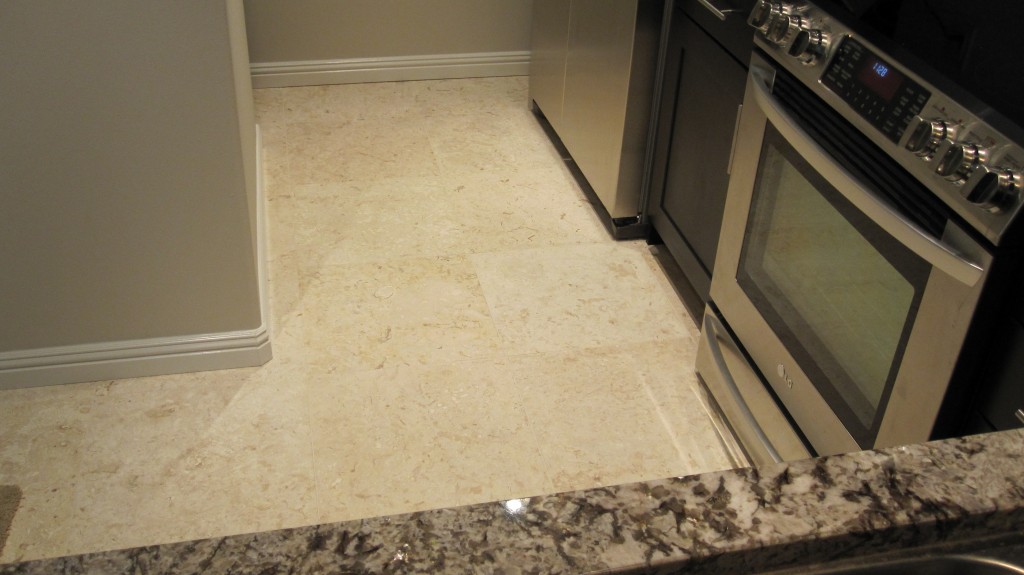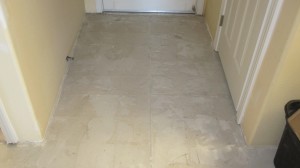We received a question yesterday about the appropriate tile underlayment (material that goes between your subfloor and tile) to use. Using the appropriate material under your tile will help your new floor last longer while providing the necessary support to prevent movement. There are several different types of underlayment available so let’s go through each option and explore the associated costs. If you need more information about the complete tile installation project, check out our previous post…Tile Installation. Be sure to discuss the information below with potential tile suppliers and/or installers and make sure you get the proper procedures put into your contract.
No Underlayment (concrete slab condition) In order for your tile floor to last, you need a solid base to support it. Any movement from the material below the floor has the potential to loosen or crack your tile or grout. When you have a concrete slab, there typically is no need to install an underlayment. You will want to check your slab for any cracks or movement prior to starting. Movement can be identified by a displaced crack. Meaning, the two sides of the crack are at different elevations. In this situation, it’s best to further investigate and solve the movement before covering. If the movement continues, your tile will either crack or loosen as the slab moves. If you determine the crack in your concrete floor is not moving, your best bet is to use a crack isolation membrane on top of the concrete before setting your tile. This will help prevent the cracking from affecting your new floor. Don’t forget to check your concrete for sealing compound on the surface. Sealing compounds on concrete can prevent the mastic from adhering properly. So, be sure to have your tile contractor remove any sealer prior to setting the tile. (If you drop water droplets onto your slab and it beads up like water on a freshly waxed car…it has a sealer on it)
Plywood When you are placing tile over a wood framed floor, one option is to use a 1/2″ thick (or greater) plywood. The plywood is installed perpendicular to the subflooring with joints staggered. The joints represent a weak point in the underlayment and subfloor so you want to make sure your installer staggers these. You never want to use plywood for a wet location…like in a shower. It can be used in a bathroom, as long as it’s on a floor that doesn’t regularly get water. Be sure to check with your material supplier to get the appropriate fastening methods to include in your installer’s contract. One last note, make sure the plywood is certified to be used as an underlayment. As of today, I found a panel of 1/2″x4x8 plywood underlayment for $14.47.
Cement Board Cement board is your second option for a suitable base over a framed floor. Water durable and sometimes mold resistant, cement board is the best product to use under tile in wet locations (but can also be used in dry locations). Typically heavier than plywood, cement board uses up a little extra energy when moving around. As of today, I found a panel of Durock brand cement board for $26.50 (1/2″x4x8 panel). Needless to say, cement board is quite a bit more expensive than plywood.
Mortar Bed Professional tile contractors often put down what they call a mortar, or “mud” bed over framed subfloors. It consists of a layer of roofing felt, then wire mesh (or similar product), then mortar. The big advantage this method has over the individual panels (cement board or plywood) is the way the whole surface under the tile acts as one. There are no joints to weaken the surface. The other advantage being the mortar can be leveled to compensate for a sublfoor that has a low spot or two. The biggest disadvantage for the mud bed underlayment is the time required for drying. Unfortunately, the price for installation varies greatly from contractor to contractor so I can’t give you a good cost estimate.
There are many other variations for suitable underlayment under your new tile floors. It’s best to talk to your tile supplier to find out what they recommend for your particular tile choice prior to bidding out the job. Have you ever thought about building your own home? Be sure to stop by the Armchair Builder How to Build Your Own Home resource page.




[…] Tile Underlayment Options Article […]